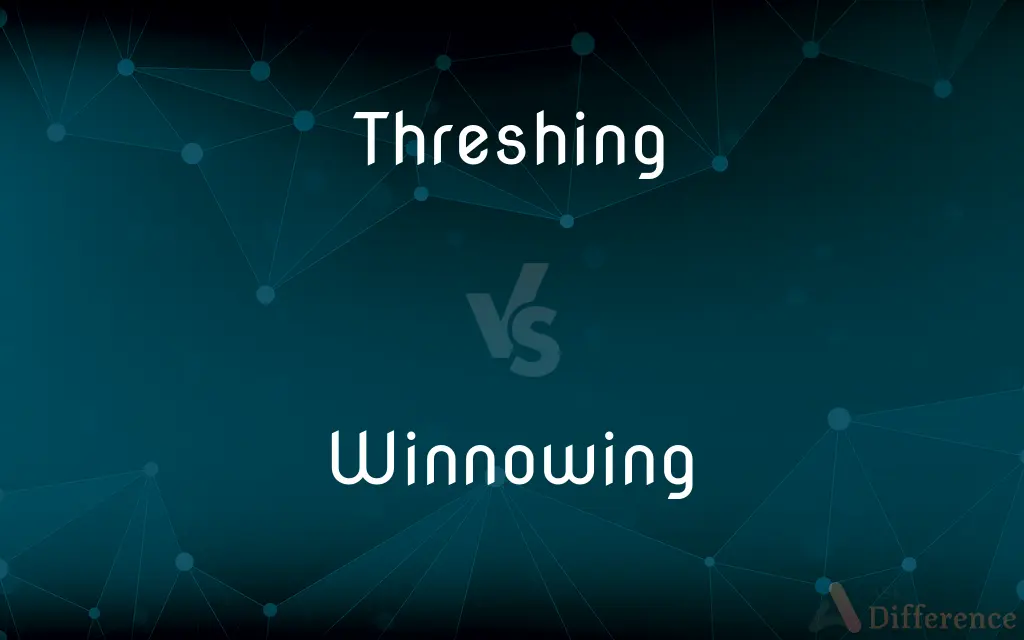Threshing vs. Winnowing — What's the Difference?
By Tayyaba Rehman & Maham Liaqat — Updated on April 4, 2024
Threshing separates grain from stalks, while winnowing separates grain from chaff using air.

Difference Between Threshing and Winnowing
Table of Contents
ADVERTISEMENT
Key Differences
Threshing and winnowing are two agricultural processes used for separating grain from its husks and impurities, but they target different parts of the crop and use distinct methods. Winnowing, on the other hand, follows threshing and uses air flow to separate the lighter chaff (the husks and other debris) from the heavier grains. This is often done by tossing the mixture into the air and allowing the wind to carry away the lighter chaff, leaving the grain to fall back down.
While threshing is concerned primarily with detaching the edible part of the grain from the inedible stalk, winnowing is focused on cleaning the grain of lighter impurities. Threshing requires physical force or machinery to break apart the grain from its stalk, making it a more labor-intensive or equipment-dependent process. Winnowing relies on the natural element of wind or a controlled air flow, making it a process that can be done with minimal equipment but requires a certain technique to be effective.
The importance of threshing lies in its ability to efficiently prepare the grain for further processing or direct consumption. Without threshing, the grain remains attached to the stalk, making it difficult to store, sell, or consume. Winnowing is crucial for the quality of the final product, as it removes the chaff, which is not only inedible but can also affect the taste, storage, and overall quality of the grain.
Both threshing and winnowing are vital steps in the post-harvest process, ensuring that the grain is usable and free of impurities. However, the sequence in which they are performed is important; threshing comes first to release the grain, and winnowing is performed afterwards to clean it. In modern agriculture, these processes are often mechanized, but in many parts of the world, traditional methods are still in use, highlighting the enduring significance of these agricultural practices.
Despite their differences, threshing and winnowing are complementary processes in the journey of grain from field to table. Threshing makes it possible to access the edible part of the crop, while winnowing ensures that what remains is clean and ready for consumption or sale. Together, they embody the essential stages of post-harvest grain processing, each with its unique method and purpose.
ADVERTISEMENT
Comparison Chart
Definition
The process of separating grain from stalks and husks.
The process of removing chaff from grain using air flow.
Purpose
To detach edible grain parts from inedible stalks.
To clean the grain of lighter impurities like chaff.
Method
Physical force or machinery.
Air flow, often using natural wind or a controlled breeze.
Focus
Separation of grain from stalk.
Separation of grain from chaff and debris.
Equipment
Manual tools or mechanical threshers.
Minimal, sometimes using simple tools or baskets.
Compare with Definitions
Threshing
Utilize mechanical threshers for efficiency.
Modern farms use advanced threshers that minimize grain loss.
Winnowing
Involves tossing the mixture into the air.
Traditionally, winnowing was done by hand on windy days for natural separation.
Threshing
A process to separate grain from stalks and husks.
The farmer used a mechanical thresher to speed up the threshing process.
Winnowing
The act of separating grain from chaff using air.
After threshing, the farmer winnowed the grain to remove the chaff.
Threshing
Involved beating sheaves against a floor or using animals.
Historically, threshing was done by hand or with the help of livestock.
Winnowing
Requires a technique to effectively separate chaff from grain.
Proper winnowing technique ensures maximum purity of the grain.
Threshing
Can be labor-intensive or require operation knowledge.
Operating mechanical threshers efficiently requires specific skills and training.
Winnowing
Often simple, like baskets or trays.
Simple tools like winnowing baskets are used to facilitate the process.
Threshing
Essential for preparing grain for consumption or sale.
Threshing is a crucial step to ensure the grain is ready for the market.
Winnowing
Removes impurities that affect grain quality.
Winnowing improves the storage life and quality of the grain.
Threshing
Threshing is the process of loosening the edible part of grain (or other crop) from the straw to which it is attached. It is the step in grain preparation after reaping.
Winnowing
Winnowing is a process by which chaff is separated from grain. It can also be used to remove pests from stored grain.
Threshing
The process of separating grain from corn or other crops
Farm workers started the afternoon's threshing
Winnowing
To separate the chaff from (grain) by means of a current of air.
Threshing
To beat the stems and husks of (grain or cereal plants) with a machine or flail to separate the grains or seeds from the straw.
Winnowing
To blow (chaff) off or away.
Threshing
To separate (grains or seeds) in this manner.
Winnowing
To examine closely in order to separate the good from the bad; sift
The judges winnowed a thousand essays down to six finalists.
Threshing
To discuss or examine (an issue, for example) repeatedly.
Winnowing
To separate or get rid of (an undesirable part); eliminate
Winnowing out the errors in logic.
Threshing
To beat severely; thrash.
Winnowing
To sort or select (a desirable part); extract
The investigators winnowed the facts from the testimony.
Threshing
To use a machine or flail to separate grain or seeds from straw.
Winnowing
To blow on; fan
A breeze winnowing the tall grass.
Threshing
To thrash about; toss.
Winnowing
To separate grain from chaff.
Threshing
Present participle of thresh
Winnowing
To separate the good from the bad.
Threshing
The process by which something is threshed.
Winnowing
A device for winnowing grain.
Threshing
The separation of grain or seeds from the husks and straw;
They used to do the threshing by hand but now there are machines to do it
Winnowing
An act of winnowing.
Winnowing
Present participle of winnow
Winnowing
The act of separating chaff from grain.
Winnowing
The act of one who, or that which, winnows.
Winnowing
The act of separating grain from chaff;
The winnowing was done by women
Common Curiosities
Can threshing and winnowing be done without machinery?
Yes, traditional methods involve manual labor and simple tools, though they are more time-consuming.
How have modern advancements affected threshing and winnowing?
Mechanization has made both processes more efficient, reducing labor and improving yield.
What is winnowing?
The process of separating grain from chaff using air flow, often after threshing.
Why is threshing important in agriculture?
It prepares the grain for further processing, consumption, or sale by separating it from the stalk.
How does winnowing improve grain quality?
By removing lighter impurities like chaff, it ensures the grain is clean and of high quality.
Why is technique important in winnowing?
Effective technique ensures maximum separation of grain from chaff, impacting quality and yield.
Are there any environmental impacts of mechanizing these processes?
Mechanization can increase efficiency but also has impacts, such as fuel consumption and habitat disruption.
What is threshing?
The process of separating grain from stalks and husks, usually involving physical force or machinery.
Is winnowing necessary after threshing?
Yes, to ensure the grain is clean and free of impurities, winnowing is a crucial step.
What equipment is used for winnowing?
Simple tools like baskets or specialized machines in modern agriculture.
How do traditional and modern methods of threshing differ?
Traditional methods rely on manual labor, while modern methods use mechanical threshers.
Can threshing damage the grain?
If not done properly, threshing can lead to grain damage, emphasizing the need for careful handling.
What role does wind play in winnowing?
Wind is used to carry away the lighter chaff while the heavier grain falls straight down.
Share Your Discovery

Previous Comparison
Seen vs. Scene
Next Comparison
Intramodal vs. IntermodalAuthor Spotlight
Written by
Tayyaba RehmanTayyaba Rehman is a distinguished writer, currently serving as a primary contributor to askdifference.com. As a researcher in semantics and etymology, Tayyaba's passion for the complexity of languages and their distinctions has found a perfect home on the platform. Tayyaba delves into the intricacies of language, distinguishing between commonly confused words and phrases, thereby providing clarity for readers worldwide.
Co-written by
Maham Liaqat















































